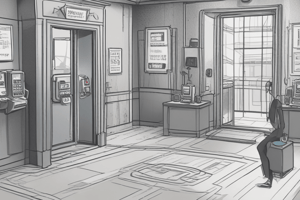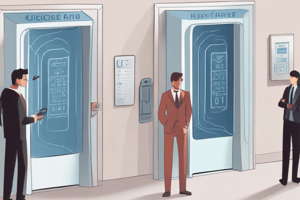Podcast
Questions and Answers
What is the primary focus of the identification phase in access control?
What is the primary focus of the identification phase in access control?
- To grant access based on predefined policies.
- To track the actions of users within the system.
- To verify the identities of users attempting to access assets.
- To determine who is requesting access to an asset. (correct)
Which phase is responsible for verifying whether individuals can be authenticated?
Which phase is responsible for verifying whether individuals can be authenticated?
- Authorization
- Authentication (correct)
- Accountability
- Identification
What does the authorization phase determine?
What does the authorization phase determine?
- How user actions are traced back to them.
- Which individuals are requesting access.
- Who is allowed to make system changes.
- What actions individuals can perform on assets. (correct)
During which phase are requests for access either granted or rejected?
During which phase are requests for access either granted or rejected?
How are actions traced to an individual according to the four phases of access control?
How are actions traced to an individual according to the four phases of access control?
What is the primary purpose of access controls in an IT infrastructure?
What is the primary purpose of access controls in an IT infrastructure?
Which of the following best describes a key concept related to access controls?
Which of the following best describes a key concept related to access controls?
What does the process of defining access control primarily aim to achieve?
What does the process of defining access control primarily aim to achieve?
Why are mitigations important in access control?
Why are mitigations important in access control?
What role do formal models of access control play in information security?
What role do formal models of access control play in information security?
Access control primarily aims to protect which aspect of a resource?
Access control primarily aims to protect which aspect of a resource?
Which of the following is NOT a component of managing access controls?
Which of the following is NOT a component of managing access controls?
What outcome do effective access controls aim to achieve in an IT environment?
What outcome do effective access controls aim to achieve in an IT environment?
What is the primary function of a security kernel in a computing environment?
What is the primary function of a security kernel in a computing environment?
Which of the following is a key feature of the reference monitor concept?
Which of the following is a key feature of the reference monitor concept?
How does the reference monitor verify access requests?
How does the reference monitor verify access requests?
Which of the following can a security kernel be implemented as?
Which of the following can a security kernel be implemented as?
What role does the central point of access control play in a security kernel?
What role does the central point of access control play in a security kernel?
What is required for a subject to access an object in a security context?
What is required for a subject to access an object in a security context?
In terms of security, what ensures that access control is consistently enforced throughout a system?
In terms of security, what ensures that access control is consistently enforced throughout a system?
Which characteristic is NOT associated with the access control managed by a security kernel?
Which characteristic is NOT associated with the access control managed by a security kernel?
Which biometric method primarily relies on the unique characteristics of an individual's eye?
Which biometric method primarily relies on the unique characteristics of an individual's eye?
What does action-based authentication primarily focus on?
What does action-based authentication primarily focus on?
Which biometric identification method is most likely to utilize fingerprints?
Which biometric identification method is most likely to utilize fingerprints?
Authentication by location is considered a strong indicator of what?
Authentication by location is considered a strong indicator of what?
Which of the following biometric identification techniques analyzes how you type?
Which of the following biometric identification techniques analyzes how you type?
Which biometric method involves analyzing the shape and structure of a person's hands?
Which biometric method involves analyzing the shape and structure of a person's hands?
What technique is NOT classified under biometric methods?
What technique is NOT classified under biometric methods?
Which type of biometric does NOT rely on a physical characteristic?
Which type of biometric does NOT rely on a physical characteristic?
What is the main advantage of using Single Sign-On (SSO)?
What is the main advantage of using Single Sign-On (SSO)?
Which access control model emphasizes the importance of data confidentiality?
Which access control model emphasizes the importance of data confidentiality?
Which of the following is a challenge of implementing Single Sign-On (SSO)?
Which of the following is a challenge of implementing Single Sign-On (SSO)?
What role does the Biba integrity model primarily serve?
What role does the Biba integrity model primarily serve?
Which protocol is NOT associated with Single Sign-On processes?
Which protocol is NOT associated with Single Sign-On processes?
What is a key purpose of log files in accountability policies?
What is a key purpose of log files in accountability policies?
In which scenario would the Clark and Wilson integrity model be most applicable?
In which scenario would the Clark and Wilson integrity model be most applicable?
The Menu Constrained User Interface is primarily used to:
The Menu Constrained User Interface is primarily used to:
Data retention policies are implemented mainly to:
Data retention policies are implemented mainly to:
What does media disposal refer to in accountability procedures?
What does media disposal refer to in accountability procedures?
Which of the following is NOT an integrity model mentioned?
Which of the following is NOT an integrity model mentioned?
Which of the following is NOT a process related to Single Sign-On (SSO) implementation?
Which of the following is NOT a process related to Single Sign-On (SSO) implementation?
The Brewer and Nash integrity model is designed to:
The Brewer and Nash integrity model is designed to:
What is a key characteristic of the Menu Constrained User Interface?
What is a key characteristic of the Menu Constrained User Interface?
Monitoring and reviews in accountability policies primarily serve what purpose?
Monitoring and reviews in accountability policies primarily serve what purpose?
Which model focuses specifically on the needs of integrity in a business environment?
Which model focuses specifically on the needs of integrity in a business environment?
Flashcards
Access Control Role
Access Control Role
Access control protects resources by restricting use to authorized individuals.
Access Control Purpose
Access Control Purpose
Access control prevents unauthorized access to resources.
Access Control Technologies
Access Control Technologies
The methods and systems used to implement access control.
Formal Access Control Models
Formal Access Control Models
Signup and view all the flashcards
Identity Management
Identity Management
Signup and view all the flashcards
System Access Controls, Maintenance
System Access Controls, Maintenance
Signup and view all the flashcards
Access Control Protection
Access Control Protection
Signup and view all the flashcards
IT Infrastructure's Role
IT Infrastructure's Role
Signup and view all the flashcards
Identification in Access Control
Identification in Access Control
Signup and view all the flashcards
Authentication in Access Control
Authentication in Access Control
Signup and view all the flashcards
Authorization in Access Control
Authorization in Access Control
Signup and view all the flashcards
Accountability in Access Control
Accountability in Access Control
Signup and view all the flashcards
Policy Enforcement Phase
Policy Enforcement Phase
Signup and view all the flashcards
Security Kernel
Security Kernel
Signup and view all the flashcards
Access Control
Access Control
Signup and view all the flashcards
Reference Monitor
Reference Monitor
Signup and view all the flashcards
Access Request
Access Request
Signup and view all the flashcards
Subject
Subject
Signup and view all the flashcards
Object
Object
Signup and view all the flashcards
Access Permissions
Access Permissions
Signup and view all the flashcards
Security Kernel Role
Security Kernel Role
Signup and view all the flashcards
Biometric Authentication
Biometric Authentication
Signup and view all the flashcards
Fingerprint Recognition
Fingerprint Recognition
Signup and view all the flashcards
Facial Recognition
Facial Recognition
Signup and view all the flashcards
Voice Pattern Recognition
Voice Pattern Recognition
Signup and view all the flashcards
Iris Scan
Iris Scan
Signup and view all the flashcards
Keystroke Dynamics
Keystroke Dynamics
Signup and view all the flashcards
Signature Dynamics
Signature Dynamics
Signup and view all the flashcards
Authentication by Location
Authentication by Location
Signup and view all the flashcards
Single Sign-On (SSO)
Single Sign-On (SSO)
Signup and view all the flashcards
Kerberos
Kerberos
Signup and view all the flashcards
Lightweight Directory Access Protocol (LDAP)
Lightweight Directory Access Protocol (LDAP)
Signup and view all the flashcards
What are some examples of SSO processes?
What are some examples of SSO processes?
Signup and view all the flashcards
Log Files
Log Files
Signup and view all the flashcards
Data Retention Policy
Data Retention Policy
Signup and view all the flashcards
Compliance Requirements
Compliance Requirements
Signup and view all the flashcards
Menu Constrained UI
Menu Constrained UI
Signup and view all the flashcards
Bell-LaPadula Model
Bell-LaPadula Model
Signup and view all the flashcards
Biba Integrity Model
Biba Integrity Model
Signup and view all the flashcards
Clark and Wilson Integrity Model
Clark and Wilson Integrity Model
Signup and view all the flashcards
Brewer and Nash Integrity Model
Brewer and Nash Integrity Model
Signup and view all the flashcards
Access Control Models
Access Control Models
Signup and view all the flashcards
What is the purpose of security models like Bell-LaPadula and Biba?
What is the purpose of security models like Bell-LaPadula and Biba?
Signup and view all the flashcards
What is the difference between Bell-LaPadula and Biba?
What is the difference between Bell-LaPadula and Biba?
Signup and view all the flashcards
Study Notes
Access Controls in IT Infrastructure
- Access controls are crucial for protecting IT infrastructure from unauthorized use.
- They involve the process of managing and controlling who can access resources and data.
- The key components of access control include identification, authentication, authorization, and accountability.
Four Phases of Access Control
- Identification: Determining who is requesting access to an asset.
- Authentication: Verifying the identity of the user.
- Authorization: Defining what access rights the user has.
- Accountability: Ensuring actions taken are traceable to specific users.
Policy Definition and Enforcement Phases
- Policy definition phase: Defines who has access to what systems/resources.
- Policy enforcement phase: Grants or denies access based on the defined policy.
- Both phases work closely with identification and authentication, and are critical in accountability.
Two Types of Access Controls
- Physical controls: Regulate access to physical locations like buildings, parking lots, and secure areas.
- Logical controls: Control access to computer systems and networks.
Physical Access Control
- Examples of physical access control include smart cards.
- Smart cards are programmed using an ID number for controlling entry into various areas.
- Some office buildings may use additional after-hours cards for access.
Logical Access Control
- Logical access control focuses on deciding user access to systems.
- It involves monitoring and controlling user behavior within the system.
What is a Kernel?
- The kernel is the core of an operating system.
- It provides basic services that other OS parts use.
- It acts as an intermediary between hardware and the rest of the OS.
- It handles process and memory management, filesystems, device control, and networking.
The Security Kernel
- The Security Kernel is the part of the OS used to enforce access control policies.
- It's the central point for access control.
- It implements the reference monitor concept—a secure mechanism to allow only authorized access to resources.
What is a Security Kernel?
- The security kernel is the core of a secure computing environment.
- It can be hardware, software or firmware based.
- It's the central location for establishing access permissions.
Enforcing Access Control
- The security kernel intercepts access requests.
- It checks access rules against the security kernel database.
- If allowed, the kernel grants access to the requested resource.
- All access attempts are logged for later analysis.
Drafting Access Control Policies
- Policies include defining users, resources, actions allowed, and relationships between them.
- Users are individuals or processes using the system.
- Resources are protected objects within the system.
- Actions are specific operations authorized users can perform.
- Relationships may include dependencies or constraints between different items.
Logical Access Control Solutions
- Biometrics: Static (fingerprints, iris scans) and dynamic (signatures, voice) methods.
- Tokens: Used for authentication, they generate one-time passwords or hashed values.
- Passwords: Must be strong, have procedures for secure management.
- Single sign on: Allows users to access multiple systems with a single login.
Asynchronous vs Synchronous Tokens
- Asynchronous tokens: Generate a unique response to a challenge. These usually have a time interval between generations.
- Synchronous tokens: Time or event based, such as one-time passwords.
Smart Cards Access Control
- Smart cards require knowledge-based authentication (PIN).
- Authentication protocols validate access.
- Kerberos is a common protocol.
Authorization Policies
- Authorization policies grant or deny permissions to users or user groups.
- Policies define different types of users (individuals or groups), actions and objects.
Methods and Guidelines for Identification
- Identification methods include usernames, smart cards, and biometrics.
- Proper guidelines ensure processes for actions and accounting are correctly implemented.
Authentication Types
- Authentication is about verifying users' identities.
- Common methods include knowledge (passwords), ownership (tokens), characteristics (biometrics), location (location-based), and actions (action-based).
Authentication by Knowledge
- Passwords, as a knowledge-based authentication factor, can lead to security risks.
- Strong passwords or passphrases are important to avoid compromise.
Authentication by Ownership
- Time-based, event-based and continuous authentication systems use tokens.
- Smart cards, USB tokens, and memory cards are common ownership-based authentication methods
Authentication by Characteristics/Biometrics
- Static biometrics measure physical characteristics (fingerprints, iris scans).
Authentication by Location and Action
- Location-based authentication uses location to verify users.
Single Sign-On (SSO)
- SSO (Single Sign-On) allows users to access multiple systems with a single login.
- It reduces errors associated with managing numerous credentials.
- Implementing SSO may be challenging.
SSO Processes (Implementation)
- Several protocols and systems can support SSO, including Kerberos, Sesame, and LDAP.
Policies and Procedures for Accountability
- Keeping logs of all related information, and procedures regarding record keeping, storage and disposal of sensitive material, and compliance requirements are important.
Formal Models of Access Control
- DAC (Discretionary Access Control): Resource owners set the access permissions.
- MAC (Mandatory Access Control): Security policy defines access restrictions.
- Non-discretionary Access Control: Access rules are strictly managed by security administrators
- Rule-based Access Control: Rules determine access permissions based on attributes and policies.
Discretionary Access Control (DAC)
- Resource owners decide on access permissions.
- OS-based DAC uses system-level access control mechanisms (users, groups).
- Application-based policies allow only authorized actions in specific contexts/applications.
Application-based DAC Example
- Applications define access based on context and content.
- Users are only presented with options they are explicitly authorized to perform.
Mandatory Access Control (MAC)
- Sensitivity levels determine resource access restrictions (the sensitivity/classification labels).
- Temporal isolation restricts access based on specific times.
MAC Bell-La Padula confidentiality model
- A model for ensuring confidentiality in access control.
- Access privileges are granted based on security labels.
MAC Subjects and Objects labels
- Sensitivity labels (e.g., Confidential, Top Secret) classify resources (objects).
- Clearance levels (e.g., Authorised) assign different privilege levels or access restrictions to individuals.
Rule-Based Access Control (ABAC)
- Access control based on rules and user attributes.
- Data owners define rules to determine who gets access, which actions can be performed, and with what data object.
Nondiscretionary Access Control
- Security administrators manage access rules, rather than resource owners.
- This approach enhances security and integrity for sensitive data and resources
Access Control Lists (ACL)
- Access control lists specify permissions for users and resources.
- ACLs are used in Linux and OS X for managing access to files and folders.
- Windows systems also use ACLs for sharing resources and permissions.
Role-Based Access Control (RBAC)
- An access control model that assigns access rights based on roles assigned to users.
- This system helps manage access control with fewer issues based on the users.
Content-Dependent Access Control
- Access to resources is contingent or based on information contained within those resources (like specific data content). This approach is especially useful in data security.
Constrained User Interface
- User interfaces restrict access based on user permissions. This type of access control involves menus, database views and also physical restrictions on user interfaces.
Physical Constrained User Interface Example
- ATMs have constrained user interfaces, where available options vary based on user status or permissions. (ATM Example)
Menu Constrained User Interface Example
- Applications (like a retail system) restrict user options in an interface to what they are authorized to perform. (Retail System Example).
Other Access Control Models
- Different models for access control mechanisms are discussed here, including the Bell-LaPadula, Biba integrity, Clark-Wilson integrity, and Brewer-Nash integrity models.
Effects of Breaches in Access Control
- Breaches in access control lead to losses of intellectual property, revenue, and trust.
- Consequences of violations must be addressed to improve security.
Threats to Access Controls
- Attackers attempt to overcome safeguards, using a variety of techniques like physical access or intercepting communication.
Credential and Permissions Management
- Systems that manage credentials.
- Microsoft's implementation of this—and other systems are detailed, especially in relation to central management of access, permissions and data.
Centralized and Decentralized Access Control
- Centralized systems use single authentication servers for multiple systems.
- Decentralized systems assign control to users responsible for handling data and controlling access closest to the user performing actions.
Decentralized Access Control
- Access control resides in the hands of system users who are closer to the subject needing access. (Examples include PAP, CHAP, Mobile device authentication, and one-time passwords (HOTP, TOTP).
Privacy
- Privacy expectations are communicated through policies, as well as in notices and banners.
- Monitoring employee use in the workplace (email, phone logs, web browsing) may impact privacy.
Studying That Suits You
Use AI to generate personalized quizzes and flashcards to suit your learning preferences.




